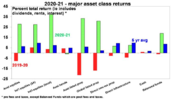The 3 million workers who partook of the Liberal government's "Early Access To Your Super" scheme, sadly sold out at the worst possible time ,from the 20th April,last year,with the ASX trading 25% below its pre pandemic peak.
According to (left-leaning) Mckell Institute, that $36.4 Billion would now be worth $41.1 Billion."And that loss only compounds over time" says Mckell's executive director.
Not entirely true.
A friend of mine took out the maximum $20k allowed and used it to trade the market. Current balance is $26k. That is a 30% return in 11 months, far better than the super fund would have provided.


